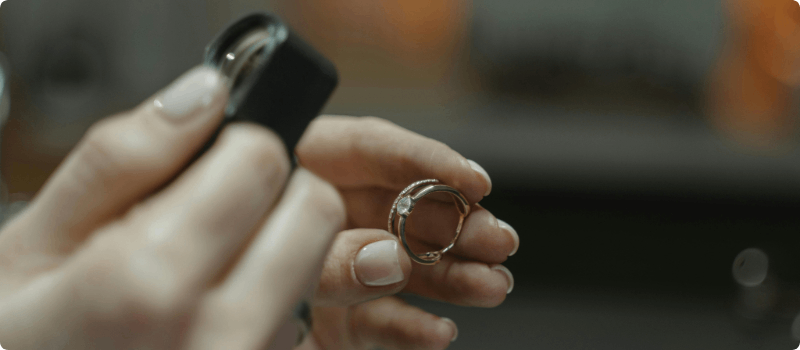How to Insure Jewelry
Updated April 9, 2024 . AmFam Team
That's why you keep your collection in a safe place and wear each piece with care. Because your jewelry is so valuable, we offer extra insurance called itemized personal property coverage. It helps protect your collection with selectable coverage types and limits.

How does jewelry insurance work?
If you think your jewelry is already covered by your home, condo or renters insurance policy, you may be partially correct. Most homeowners policies may cover jewelry, but the protection is limited because jewelry is often highly valuable and easily lost.
Talk to your insurance agent about your existing coverage limits for your jewelry. As you discuss your options, consider what works best for you. If you have valuable pieces you won't be able to replace in the event of a loss, ask your agent to increase your itemized personal property coverage limits. The increased limits may give you peace of mind in the event of an unexpected loss.

How much does jewelry insurance cover?
Your standard homeowners personal property coverage may cover between $1,000 and $2,000 for all your jewelry combined. Your chosen deductible will also impact your claim payout.
If the total value of your jewelry exceeds your policy's jewelry limit, you may benefit from increasing your limits. You can increase your total coverage limit for jewelry under your homeowners insurance policy or by itemizing specific jewelry items through itemized personal property coverage.
In addition to providing more coverage for high-value items, increasing your coverage limits may help protect a broader range of losses. If you itemize, covered items may even be protected if you accidentally lose or damage them.

What types of jewelry are covered?
Common types of jewelry covered by your home insurance policy include:
- Wedding bands
- Diamond rings
- Watches
- Antique jewelry
- Engagement rings
Your agent can help you determine what jewelry to insure and if it qualifies for coverage.

How much does jewelry insurance cost?
While your jewelry insurance premium depends on various factors, coverage typically costs between one to two percent of the value of your jewelry.
The premium is also affected by the deductible you choose. Remember that a deductible is what you’ll pay out of pocket when you file a claim. A lower deductible typically results in a higher premium, and a higher deductible usually results in a lower premium.
To help protect your finances and pay less out of pocket in the event of an unexpected loss, consider adding diminishing deductible coverage to your home insurance policy.

Should you insure jewelry?
Check your homeowners policy or speak with your insurance agent to determine your coverage limits and terms. If the value of your jewelry exceeds your limits, increasing your coverage limits may help better protect it.
Consider the following when deciding if you need jewelry insurance:
- Would you be able to cover the cost of replacing your jewelry in the event of a loss?
- Are you afraid to wear certain jewelry items due to fear of losing or damaging them?
- Do you have a large collection of jewelry?
With itemized jewelry insurance, you can increase your coverage amount to help replace your jewelry after an unexpected loss, whether it's one piece or your entire collection. Jewelry insurance costs vary based on your coverage needs.
Itemized personal property, otherwise known as scheduled personal property, is an open peril policy as opposed to a named peril policy. A named peril policy only protects against the types of losses specifically listed (or named) on your policy. An open peril policy broadens your coverage by insuring your jewelry for all losses unless expressly excluded by your policy. The right coverage type and limits may help give you peace of mind when wearing your jewelry.

What is included with jewelry insurance?
Opting to add itemized personal property coverage to your homeowners policy may help protect you from these types of losses:Lost Jewelry
Standard homeowners policies don't typically cover lost jewelry as a named peril. However, adding itemized coverage may help protect you from this type of loss.
Theft
Your homeowners policy may help protect your jewelry from theft, but only up to your standard policy's limits. For example, a typical limit may be $2,000. If your jewelry is worth more than your coverage, itemized personal property insurance may help better protect you.
Damage
Jewelry insurance with itemized personal property may help repair a bent prong or replace a missing stone if the damage is accidental and not due to usual wear and tear.
Many itemized personal property policies have a zero-deductible option for an increased premium. But if you opt for a policy with a deductible, remember that you must pay your deductible before your insurer can pay its portion of your claim's balance.
Worldwide Jewelry Insurance
Jewelry insurance protects your belongings at home and on the go. Before going abroad, review your jewelry collection and adjust your coverage limits if required. This added step can help better protect your valuables from the unexpected.

How to Insure Your Jewelry
To insure your jewelry, you’ll likely need to provide your insurance company with one or more of the following items:
- Receipts
- Appraisals
- Certificates
- Photos of your jewelry
Once you have those important items set aside, consider asking your jewelry insurance provider these key questions:
Do coverage limits fluctuate with the prices of precious metals or gems?
The value of precious metals and gems tends to change over time. This knowledge may help you better understand the pricing structure of your insured items.
How often can/should you submit updated appraisals?
Update requirements vary depending on your selected insurer and policy. Before enrolling, ask your chosen insurance company about its policies to ensure you get the coverage you need.
What proof of loss or damage will be required?
Insurers have different requirements for proof of loss or damage to your items. Ask your insurance company to clarify its policies to help ensure your claims process goes smoothly in the event of a loss.
Which exclusions does the policy have, and what types of loss and damage are not covered?
This crucial information helps ensure your jewelry is insurable with your chosen provider.

Protect Your Valuables with Jewelry Insurance Today
A good insurance policy helps protect your jewelry, whether stolen, lost, damaged in a fire or if valuable stones go missing. To help protect your precious valuables, ask your American Family Insurance agent about our itemized personal property insurance today.
This information represents only a brief description of coverages, is not part of your policy, and is not a promise or guarantee of coverage. If there is any conflict between this information and your policy, the provisions of the policy will prevail. Insurance policy terms and conditions may apply. Exclusions may apply to policies, endorsements, or riders. Coverage may vary by state and may be subject to change. Some products are not available in every state. Please read your policy and contact your agent for assistance.


